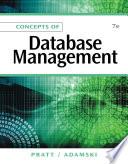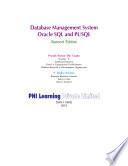Database Management System (DBMS) and Oracle are essentially a part of the curriculum for undergraduate and postgraduate courses in Computer Science, Computer Applications, Computer Science and Engineering, Information Technology and Management. The book is organized into three parts to introduce the theoretical and programming concepts of DBMS. Part I (Basic Concepts and Oracle SQL) deals with DBMS basic, software analysis and design, data flow diagram, ER model, relational algebra, normal forms, SQL queries, functions, subqueries, different types of joins, DCL, DDL, DML, object constraints and security in Oracle. Part II (Application Using Oracle PL/SQL) explains PL/SQL basics, functions, procedures, packages, exception handling, triggers, implicit, explicit and advanced cursors using suitable examples. This part also covers advanced concepts related to PL/SQL, such as collection, records, objects, dynamic SQL and performance tuning. Part III (Advanced Concepts and Technologies) elaborates on advanced database concepts such as query processing, file organization, distributed architecture, backup, recovery, data warehousing, online analytical processing and data mining concepts and their techniques. All the chapters include a large number of examples. To further reinforce the concepts, numerous objective type questions and workouts are provided at the end of each chapter. Key Features • Explains each topic in a step-by-step detail.• Includes about 300 examples to illustrate the concepts. • Offers about 400 objective type questions to quiz students on key points.• Provides about 100 challenging workouts that invite deeper analysis and interpretation of the subject matter. New to the Second Edition • The book reorganized into three parts for better understanding of DBMS concepts.• All the existing chapters thoroughly revised and eight new chapters added.• New chapters discuss Oracle PL/SQL advanced programming concepts, data warehousing, OLTP, OLAP and data mining concepts.• Additional examples, questions and workouts in each chapter. TEACHING AID MATERIAL Teaching Aid Material for all the chapters is provided on the website of PHI Learning, which can be used by the faculties/teachers for delivering lectures. Visit www.phindia.com/gupta to explore the contents.
The book is organized into three parts to introduce the theoretical and programming concepts of DBMS.









